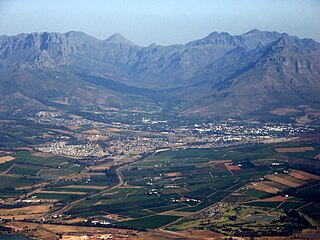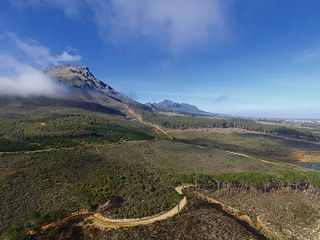
Boschendal (Dutch: bush and dale) is one of the oldest wine estates in South Africa and is located between Franschhoek and Stellenbosch in South Africa's Western Cape.

Boschendal (Dutch: bush and dale) is one of the oldest wine estates in South Africa and is located between Franschhoek and Stellenbosch in South Africa's Western Cape.
The farm's title deeds are dated 1685. The estate's first owner, Jean le Long, was one of the party of 200 French Huguenot refugees who were fleeing religious persecution in Europe. He was granted land in the Cape of Good Hope by the Dutch East India Company in 1688 and the title deed was written in 1713. In 1715 the farm was acquired by another Huguenot, Abraham de Villiers, who sold it to his brother Jacques in 1717. The De Villiers family farmed Boschendal until 1879. In 1812 Paul de Villiers and his wife, Anna Susanna Louw, completed a new house at Boschendal on the site of his father's home. This is the homestead as restored today. [1] Among the guests in the later years of the De Villiers era was the British Governor at the Cape, Sir George Grey, who stayed at Boschendal whenever he visited the region. [1]
In 1887 the estate was bought by Cecil Rhodes and formed part of his commercial fruit business, Rhodes Fruit Farms which has become today's Boschendal Farm. [2]
A global phylloxera epidemic, caused by tiny, sap-sucking insects, spread through the Cape vineyards in the 1880s and 1890s, destroying the vines of the Boschendal area in 1890. It caused much damage and led to a farming depression before resistant American vine stocks were introduced on a scale wide enough to stop the epidemic. [1]
In the meantime, farmers needed alternative forms of agriculture, and the lucrative fruit industry in California provided a suitable model for the Cape. Pioneering work was done by fruit farmers in Wellington and the Hex River Valley. In 1892, shipping magnate Percy Molteno developed and introduced refrigerated cargo space on Union-Castle shipping lines, between the Cape and the largest consumer markets in Europe, which revolutionized the industry and made the export of fresh fruit an attractive proposition. [3] [4]
Harry Pickstone, an Englishman with experience of growing fruit in California, convinced Rhodes that a commercial nursery was needed to propagate new varieties of fruit trees for the industry. Rhodes financed his first venture, the Pioneer Fruit Growing Company.
Rhodes's political career had seen him rise to Prime Minister of the Cape Colony. When he was implicated in the Jameson Raid, an unsuccessful attempt to overthrow the Boer Republic in the Transvaal, he was left with little option but to resign. In 1896 Rhodes decided to invest further in fruit farming. Pickstone advised him to buy old wine farms in the Groot Drakenstein, Wellington and Stellenbosch areas.
In March 1897 Rhodes secured the first of more than 20 farms, including Boschendal and Rhone. Twelve young managers were appointed, many of whom had been trained in California. Under Pickstone's tutelage they transformed the farms, introducing modern methods of pruning, grafting and irrigation, and training farm workers in the new skills. They planted 200 000 deciduous fruit trees - pears, apricots, plums and peaches.
In its new incarnation as Boschendal - The Estate, the former "Rhodes Fruit Farms" continues to be a major source of employment for local communities. [5]
The Boschendal estate is crowned by the original Cape Dutch manor house, which is open to visitors, together with associated wine tasting venues, restaurants and outbuildings and visitor attractions.
In the late 1960s the estate was taken over by the Anglo American Corporation, before being sold in 2003 to a consortium of international investors, led by the property developer Clive Venning. In 2012 the estate was sold to a consortium of South African investors who began an intensive rejuvenation and agricultural programme.
The vineyards at Boschendal cover 2.54 km² between Groot Drakenstein and Simonsberg, and include substantial plantings of Chardonnay and Sauvignon blanc, together with recent plantings of Cabernet Sauvignon, Merlot and Shiraz. The winery is noted particularly for its complex white wines.
When Anglo American took ownership of Rhodes Fruit Farms and Boschendal in 1969 one of the key projects was the re-establishment of a range of wines under the Boschendal brand. In 1978, Achim van Arnim took charge as Cellarmaster, vowing to restore pre-eminence for the Estate's produce.
It was then that "Blanc de Noir" ( white from black) was created — a "blush" white wine made from red grapes, an innovation that sets Boschendal Wines apart. [6]

Paarl is a town with 285574 inhabitants in the Western Cape province of South Africa. It is the third-oldest city and European settlement in the Republic of South Africa and the largest town in the Cape Winelands. Due to the growth of the Mbekweni township, it is now a de facto urban unit with Wellington. It is situated about 60 kilometres (37 mi) northeast of Cape Town in the Western Cape Province and is known for its scenic environment and viticulture and fruit-growing heritage.

Stellenbosch is a town in the Western Cape province of South Africa, situated about 50 kilometres east of Cape Town, along the banks of the Eerste River at the foot of the Stellenbosch Mountain. The town became known as the City of Oaks or Eikestad in Afrikaans and Dutch due to the large number of oak trees that were planted by its founder, Simon van der Stel, to grace the streets and homesteads.

Sir Herbert Baker was an English architect remembered as the dominant force in South African architecture for two decades, and a major designer of some of New Delhi's most notable government structures. He was born and died at Owletts in Cobham, Kent.

Simon van der Stel was the first Governor of the Dutch Cape Colony (1691), the settlement at the Cape of Good Hope. He was interested in botany, establishing vineyards Groot and Klein Constantia, and producing a famous dessert wine. He is considered one of the founders of South African viticulture.
South African wine has a history dating back to 1659 with the first bottle being produced in Cape Town by its founder and gouverner Jan van Riebeeck. Access to international markets led to new investment in the South African wine market. Production is concentrated around Cape Town and almost exclusively located within the Western Cape province, with major vineyard and production centres at Constantia, Paarl, Stellenbosch and Worcester.

Groot Constantia is the oldest wine estate in South Africa and provincial heritage site in the suburb of Constantia in Cape Town, South Africa.

Klein Constantia is a wine estate in the suburb of Constantia in Cape Town, South Africa.
Adam Tas was a community leader in the Cape Colony at the turn of the 17th century, and is best known for his role in the conflict between Cape Governor Willem Adriaan van der Stel and the Free Burghers at the Cape of Good Hope.

The Drakenstein mountain opposite Simonsberg Mountain named after ex military man and Colonial administrator of the Dutch East India Company Hendrik Adriaan van Rheede tot Drakenstein is part of the Cape Fold Belt and are in the Western Cape province of South Africa.

Western Cape is a Geographical Unit within the Wine of Origin classification system of South African wine. Corresponding to the province of Western Cape it includes most of the vineyards in South Africa.

Fairview Wine and Cheese farm is a South African producer of wines and cheeses based in the Paarl region of the Western Cape province. It is owned and run by Charles Back, who also owns The Goats do Roam Wine Company and The Spice Route Winery.

The early history of the South African wine industry can be traced to the founding of a supply station at the Cape of Good Hope by the Dutch East India Company. Jan van Riebeeck was given the task of managing the station and planting vineyards to produce wine and grapes in the Wijnberg ; that could be used to ward off scurvy for sailors continuing on their voyages along the spice route. In 1685, another Cape Governor, Simon van der Stel, purchased a large 750-hectare (1,900-acre) estate, founding what later became the world-renowned Constantia wine estate. In the 19th century, South Africa fell under British rule which proved lucrative for the wine industry as South African wine flowed into the British market. This prosperity lasted until the 1860s when the Cobden–Chevalier Treaty signed by the Palmerston government and France reduced the preferential tariffs that benefited South African wine in favor of French wine exports.
Rhodes Fruit Farms, founded by Cecil John Rhodes in 1902, exists today as Boschendal The Estate, one of the oldest wine estates in South Africa.
Rietvallei Wine Estate is a wine estate in the Robertson Valley, Western Cape, South Africa.

The Spice Route Paarl is a popular tourist destination located in the city of Paarl, South Africa. Make sure to check in with vendors regarding specific operating hours. The farm is open 7 days a week but each vendor adheres to their own operating hours. The name Spice Route dates back to the historical mariners who used to trade Eastern spices to Europe along the "Spice Route" for spice trade in the 15th century. The Estate gives visitors the opportunity to explore local foods, beverages and goods, that are produced in a traditional manner supporting the local community while spreading the taste and spirit of South Africa out to the world. Its cellar production and wine tasting is conducted of red and white wines from the local Malmesbury and Darling wine yards, which received national and international attention.

Stellenbosch Mountain is a mountain forming a prominent landmark overlooking the town of Stellenbosch in the Western Cape Province of South Africa. The mountain forms part of the Coetsenburg Estate, the Jonkershoek Nature Reserve, the Assegaaibosch Nature Reserve and the larger Hottentots-Holland Mountains Catchment Area.
Coetsenburg is an historic wine estate and one of the oldest estates in South Africa, established in 1682. It is located at the foot of the Stellenbosch Mountain, which forms part of the estate, in the town of Stellenbosch, 31 miles (50 km) east of Cape Town, in the Cape Winelands of the Western Cape Province. The estate has historically been owned by the Coetsee family and is currently not open to the public. The north-western portion of the original estate is now the Coetsenburg Sports Grounds which belongs to the University of Stellenbosch.
Dirk Coetzee/Coetsee was the Hoofdheemraad (Chancellor) of the District of Stellenbosch and Drakenstein in South Africa for most of the 1690s and early 1700s. He also served as captain of the Stellenbosch Infantry and deacon of the Stellenbosch Moederkerk at different points in time. As captain of the Stellenbosch Infantry, which comprised mostly Huguenots, he provided military backing for a rebellion which began in 1706 against the Governor of the Cape Colony, Willem Adriaan van der Stel, whom the vrijburghers had accused of tyranny, corruption and racketeering. Coetsee was imprisoned in the dungeon of the Castle of Good Hope along with the other leaders of the Huguenots but he was released after a year. The rebellion ultimately succeeded in 1707 when the Dutch East India Company recalled the Governor and other colonial officials. An account of the rebellion is vividly described in the "Diary of Adam Tas".

Val de Vie Estate is a secure, luxury residential and outdoor lifestyle estate occupying 917 hectares situated between Stellenbosch, Paarl and Franschhoek in the Cape Winelands of South Africa.